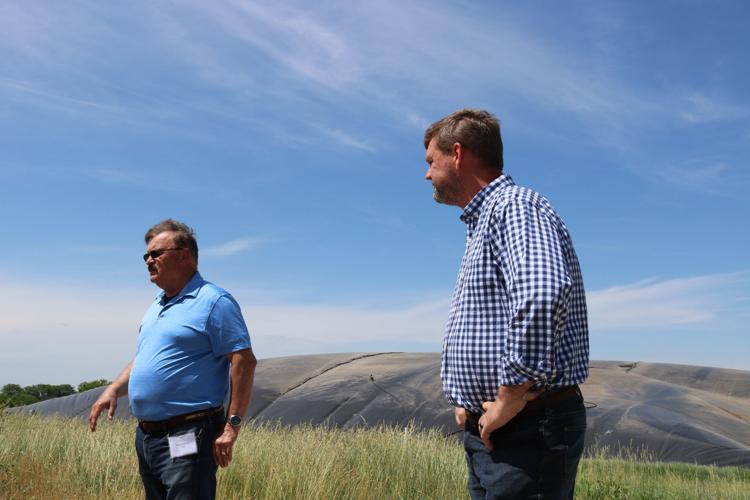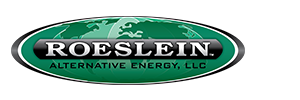Published by High Plains Journal
Written by: Laura Handke
In partnership, Roeslein Alternative Energy and Smithfield Hog Production are working to capture renewable natural gas from the waste of the approximate 2 million hogs that circulate through Smithfield’s northern Missouri operations each year.

Rudi Roeslein (RAE) and Kraig Westerbeek (Smithfield) discuss the process of capturing, extracting and transporting RNG created on Smithfield’s Milan, Missouri, hog production location. (Photo by Laura Handke.)
In early 2019, the Monarch Bio Energy partnership was created making RAE and Smithfield 50/50 partners. Today, RNG harvest operations are currently happening on 20 of Smithfield’s 88 lagoons in the region with plans underway to add another 17 in 2019. Monarch Bio Energy’s goal is to have all lagoons covered by the end of 2021.
Roeslein, an avid conservationist, says that the efforts of the partnership have the ability to change manure management and believes that the technology is a piece of the puzzle of saving the planet from greenhouse gasses.
“When you think about dealing with the waste of 2 million hogs, that requires a water treatment facility similar to that of a city the size of Kansas City or St. Louis,” Roeslein says.
The process of extracting methane from the manure seems simple; however, the technology and intricate logistics of the system are anything but.
Barns are scraped and the waste is piped into a lagoon that measures between 3 to 4 acres in area. Lagoons are covered with a heavy impermeable cover and as the methane is released from the manure the cover inflates.
“Methane is lighter than air, so it rises and inflates the covers. The gas that we extract is 65% methane, 30% carbon dioxide and the remainder is hydrogen sulfide. The gasses are separated and the product that we sell for Renewable Fuels Standards credits on the carbon market, exclusively for use in California, is 99% methane,” Roeslein says.
Monarch Bio Energy’s RNG received the lowest Carbon Intensity score ever recorded, minus 374; a number calculated from the net usages of producing, transporting and using the RNG. A lower CI score, therefore, translates to lower greenhouse gas emission rates and creates higher value in the RNG. To date, Monarch Bio Energy’s RNG is the most valuable RNG on the market.
“When you see a feed truck pull up to the farm, that’s an energy delivery. It might be corn or soybean meal, whatever it is, the animal consumes that energy. And what isn’t converted to gain is expelled. They aren’t 100% efficient and some portion of that energy is going to end up in the lagoons,” says Senior Director of Smithfield Renewables and Hog Production Division Environmental Affairs Kraig Westerbeek. “This methane collection process allows us to get the most out of our energy.”
After collection and cleaning, the RNG is transported through what the project calls a “virtual” pipeline, specially designed semi-trailers that allow the RNG to be compressed to 3600 pounds per square inch. Once transferred to the trailer, the gas is trucked to an injection point into a natural gas pipeline.
The methane from the lagoons is transferred twice per day, creating four semi-trailer loads of RNG every 24-hour period. When the northern Missouri project is complete, roughly 2 billion cubic feet of RNG per year from the region’s 88 lagoons will be injected into the pipeline—the equivalent of filling 56,000 semi-trucks with diesel.
And while RNG makes the venture economically sustainable, methane isn’t Roeslein’s only goal.
“I wanted to use my integration and engineering know-how to do this (capture RNG), but in the back of my mind, and what I kept telling Smithfield, was that I wanted wildlife to have a place. And I wanted conservation to be a part of this effort, too,” he says.
Horizon 2 of Roeslein’s project focuses on the restoration of native prairie in North Missouri and will see prairie plants sustainably harvested and digested into RNG. The project will create both another source of RNG and a new revenue stream for farmers.

